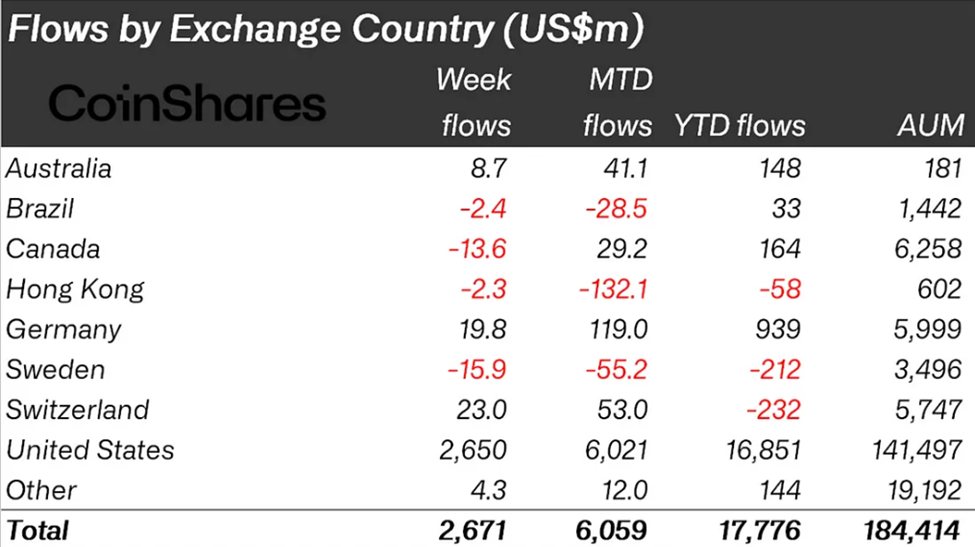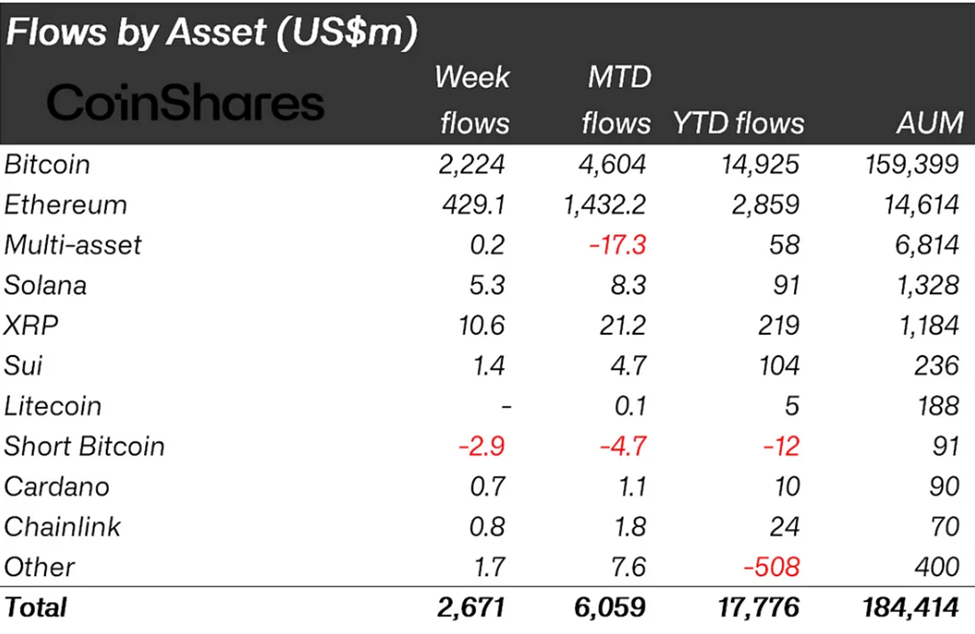| COINOTAG recommends • Exchange signup |
| 💹 Trade with pro tools |
| Fast execution, robust charts, clean risk controls. |
| 👉 Open account → |
| COINOTAG recommends • Exchange signup |
| 🚀 Smooth orders, clear control |
| Advanced order types and market depth in one view. |
| 👉 Create account → |
| COINOTAG recommends • Exchange signup |
| 📈 Clarity in volatile markets |
| Plan entries & exits, manage positions with discipline. |
| 👉 Sign up → |
| COINOTAG recommends • Exchange signup |
| ⚡ Speed, depth, reliability |
| Execute confidently when timing matters. |
| 👉 Open account → |
| COINOTAG recommends • Exchange signup |
| 🧭 A focused workflow for traders |
| Alerts, watchlists, and a repeatable process. |
| 👉 Get started → |
| COINOTAG recommends • Exchange signup |
| ✅ Data‑driven decisions |
| Focus on process—not noise. |
| 👉 Sign up → |
-
Crypto inflows surged to $2.7 billion last week, extending an 11-week streak of positive capital movement, with Bitcoin leading the charge at $2.2 billion.
-
Ethereum attracted $429 million, bolstered by the Pectra upgrade, while Solana saw minimal inflows of $91 million, reflecting varied investor confidence across altcoins.
-
Geopolitical instability and Federal Reserve policy uncertainty continue to drive investor demand for Bitcoin and Ethereum as preferred hedges in a volatile global market, according to CoinShares research.
Crypto inflows hit $2.7B last week, led by Bitcoin and Ethereum amid geopolitical and Fed policy uncertainty, signaling strong institutional demand in 2025.
Bitcoin Captures $2.2 Billion as Crypto Inflows Extend an 11-Week Winning Streak
Crypto inflows have demonstrated remarkable resilience, with last week’s $2.7 billion inflow nearly matching the record pace set in the first half of 2024. Institutional investors appear confident, especially in Bitcoin, which accounted for a dominant 83% of inflows at $2.2 billion. This trend underscores Bitcoin’s continued role as a primary store of value and hedge amid market uncertainty.
Data from CoinShares reveals that the majority of these inflows originated from the United States, contributing $2.65 billion to the total. This regional concentration highlights the growing institutional adoption of crypto assets within the US financial ecosystem.

| COINOTAG recommends • Professional traders group |
| 💎 Join a professional trading community |
| Work with senior traders, research‑backed setups, and risk‑first frameworks. |
| 👉 Join the group → |
| COINOTAG recommends • Professional traders group |
| 📊 Transparent performance, real process |
| Spot strategies with documented months of triple‑digit runs during strong trends; futures plans use defined R:R and sizing. |
| 👉 Get access → |
| COINOTAG recommends • Professional traders group |
| 🧭 Research → Plan → Execute |
| Daily levels, watchlists, and post‑trade reviews to build consistency. |
| 👉 Join now → |
| COINOTAG recommends • Professional traders group |
| 🛡️ Risk comes first |
| Sizing methods, invalidation rules, and R‑multiples baked into every plan. |
| 👉 Start today → |
| COINOTAG recommends • Professional traders group |
| 🧠 Learn the “why” behind each trade |
| Live breakdowns, playbooks, and framework‑first education. |
| 👉 Join the group → |
| COINOTAG recommends • Professional traders group |
| 🚀 Insider • APEX • INNER CIRCLE |
| Choose the depth you need—tools, coaching, and member rooms. |
| 👉 Explore tiers → |
Notably, bearish positions on Bitcoin have diminished, with short-Bitcoin products shedding $2.9 million last week, bringing year-to-date outflows on bearish bets to $12 million. This reduction in short exposure signals increasing investor confidence in Bitcoin’s medium-term outlook.
Ethereum also recorded robust inflows of $429 million, pushing its 2025 total to $2.9 billion. The altcoin’s momentum has been partly fueled by the recent Pectra upgrade, which has enhanced network efficiency and investor sentiment. In contrast, Solana’s inflows remain modest at $91 million for the year, indicating selective capital allocation within the altcoin sector.
| COINOTAG recommends • Exchange signup |
| 📈 Clear interface, precise orders |
| Sharp entries & exits with actionable alerts. |
| 👉 Create free account → |
| COINOTAG recommends • Exchange signup |
| 🧠 Smarter tools. Better decisions. |
| Depth analytics and risk features in one view. |
| 👉 Sign up → |
| COINOTAG recommends • Exchange signup |
| 🎯 Take control of entries & exits |
| Set alerts, define stops, execute consistently. |
| 👉 Open account → |
| COINOTAG recommends • Exchange signup |
| 🛠️ From idea to execution |
| Turn setups into plans with practical order types. |
| 👉 Join now → |
| COINOTAG recommends • Exchange signup |
| 📋 Trade your plan |
| Watchlists and routing that support focus. |
| 👉 Get started → |
| COINOTAG recommends • Exchange signup |
| 📊 Precision without the noise |
| Data‑first workflows for active traders. |
| 👉 Sign up → |

The recent surge builds on a strong three-week trend, with nearly $6 billion in inflows recorded over this period. This sustained capital movement reflects a strategic shift among investors, who are increasingly viewing crypto as a resilient asset class amid global economic headwinds.
| COINOTAG recommends • Traders club |
| ⚡ Futures with discipline |
| Defined R:R, pre‑set invalidation, execution checklists. |
| 👉 Join the club → |
| COINOTAG recommends • Traders club |
| 🎯 Spot strategies that compound |
| Momentum & accumulation frameworks managed with clear risk. |
| 👉 Get access → |
| COINOTAG recommends • Traders club |
| 🏛️ APEX tier for serious traders |
| Deep dives, analyst Q&A, and accountability sprints. |
| 👉 Explore APEX → |
| COINOTAG recommends • Traders club |
| 📈 Real‑time market structure |
| Key levels, liquidity zones, and actionable context. |
| 👉 Join now → |
| COINOTAG recommends • Traders club |
| 🔔 Smart alerts, not noise |
| Context‑rich notifications tied to plans and risk—never hype. |
| 👉 Get access → |
| COINOTAG recommends • Traders club |
| 🤝 Peer review & coaching |
| Hands‑on feedback that sharpens execution and risk control. |
| 👉 Join the club → |
James Butterfill, Head of Research at CoinShares, noted, “We believe this resilient investor demand has been driven by a combination of factors, primarily heightened geopolitical volatility and uncertainty surrounding the direction of monetary policy.”
Global Macro Forces Keep Crypto Inflows on Track
Macro-economic dynamics continue to underpin the robust inflows into crypto assets. Moody’s recent downgrade of the US credit outlook has intensified concerns over traditional markets, prompting investors to seek uncorrelated assets like Bitcoin and Ethereum.
Despite geopolitical tensions, including tariff threats and policy uncertainties, investor appetite for crypto remains strong, suggesting a long-term structural demand rather than short-term speculative interest.
The Federal Reserve’s ambiguous stance on interest rate cuts has further contributed to market volatility. This uncertainty has made crypto assets attractive as hedges against inflation and currency fluctuations, especially the US dollar.
| COINOTAG recommends • Exchange signup |
| 📈 Clear control for futures |
| Sizing, stops, and scenario planning tools. |
| 👉 Open futures account → |
| COINOTAG recommends • Exchange signup |
| 🧩 Structure your futures trades |
| Define entries & exits with advanced orders. |
| 👉 Sign up → |
| COINOTAG recommends • Exchange signup |
| 🛡️ Control volatility |
| Automate alerts and manage positions with discipline. |
| 👉 Get started → |
| COINOTAG recommends • Exchange signup |
| ⚙️ Execution you can rely on |
| Fast routing and meaningful depth insights. |
| 👉 Create account → |
| COINOTAG recommends • Exchange signup |
| 📒 Plan. Execute. Review. |
| Frameworks for consistent decision‑making. |
| 👉 Join now → |
| COINOTAG recommends • Exchange signup |
| 🧩 Choose clarity over complexity |
| Actionable, pro‑grade tools—no fluff. |
| 👉 Open account → |
Institutional investors are increasingly integrating crypto into diversified portfolios, viewing it as a strategic allocation rather than a speculative play. This alignment between crypto and traditional finance signals maturation in market perception and adoption.
Even as equity markets experience sideways movement and bond yields rise, digital assets continue to attract capital inflows, highlighting their growing role in global investment strategies.
| COINOTAG recommends • Members‑only research |
| 📌 Curated setups, clearly explained |
| Entry, invalidation, targets, and R:R defined before execution. |
| 👉 Get access → |
| COINOTAG recommends • Members‑only research |
| 🧠 Data‑led decision making |
| Technical + flow + context synthesized into actionable plans. |
| 👉 Join now → |
| COINOTAG recommends • Members‑only research |
| 🧱 Consistency over hype |
| Repeatable rules, realistic expectations, and a calmer mindset. |
| 👉 Get access → |
| COINOTAG recommends • Members‑only research |
| 🕒 Patience is an edge |
| Wait for confirmation and manage risk with checklists. |
| 👉 Join now → |
| COINOTAG recommends • Members‑only research |
| 💼 Professional mentorship |
| Guidance from seasoned traders and structured feedback loops. |
| 👉 Get access → |
| COINOTAG recommends • Members‑only research |
| 🧮 Track • Review • Improve |
| Documented PnL tracking and post‑mortems to accelerate learning. |
| 👉 Join now → |
Conclusion
The sustained $2.7 billion weekly inflows, led by Bitcoin and Ethereum, underscore a robust institutional conviction amid geopolitical and monetary policy uncertainties. With macroeconomic factors driving demand, crypto assets are transitioning from speculative instruments to strategic hedges within diversified portfolios. Investors should monitor these trends closely as crypto continues to integrate with traditional financial markets, offering potential resilience in an evolving global economic landscape.
| COINOTAG recommends • Members‑only research |
| 📌 Curated setups, clearly explained |
| Entry, invalidation, targets, and R:R defined before execution. |
| 👉 Get access → |
| COINOTAG recommends • Members‑only research |
| 🧠 Data‑led decision making |
| Technical + flow + context synthesized into actionable plans. |
| 👉 Join now → |
| COINOTAG recommends • Members‑only research |
| 🧱 Consistency over hype |
| Repeatable rules, realistic expectations, and a calmer mindset. |
| 👉 Get access → |
| COINOTAG recommends • Members‑only research |
| 🕒 Patience is an edge |
| Wait for confirmation and manage risk with checklists. |
| 👉 Join now → |
| COINOTAG recommends • Members‑only research |
| 💼 Professional mentorship |
| Guidance from seasoned traders and structured feedback loops. |
| 👉 Get access → |
| COINOTAG recommends • Members‑only research |
| 🧮 Track • Review • Improve |
| Documented PnL tracking and post‑mortems to accelerate learning. |
| 👉 Join now → |









